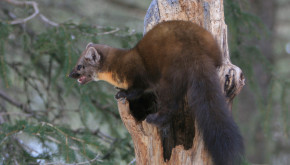
Guest post by Daniel Hubbell, communications intern for the American Forest Foundation
Growing up in Sudbury, Massachusetts I found much of my life was shaped by the town’s water district, a patch of public land located just behind my house. Aside from a few trails, most of the land was left alone, a small patch of woodland ecosystem nestled in suburbia. In fall as the colors turned I would walk through these woods, stepping over logs, and seeing the occasional dead snag standing among all the living trees.
It was only years later that I learned just how vital these pieces of dead wood are to the continued health of a woodlands ecosystem. Those seemingly dead snags can serve as “condos” to more than 80 different species of North American birds. At larger sizes the hollows in these trees are even potential hosts for bears. As for the logs on the ground, their slow decomposition enriches the soil around them and offers a den for mammals like foxes or bobcats. Salamanders and other amphibians also love the damper spots a log can afford.
In fact conservationists estimate that up to 20 percent of forested wildlife depends on dead wood like this for food, habitat, or cover. Within normal healthy woodland they are essential features, but they are often missing from more regularly maintained forests. It is just too easy to dismiss that log as potential firewood, rather than giving it the chance to live up to another potential simply by leaving the log where it lies.
Incorporating these snags and logs into a management plan, as well as building the occasional brushpile out of old wood trimmings can be a great way to attract wildlife to your land and to provide a home for countless species. Given that nearly 282 million acres of forestland are owned by 22 million family forest owners, there is a lot of potential habitat out there. That is why the American Forest created wildlife habitat content for My Land Plan, our site for woodland owners. There you can find all the tips and resources you need to incorporate dead wood into your land and management plan. Before too long you may see signs of life peeking out from a gnarled old snag.

